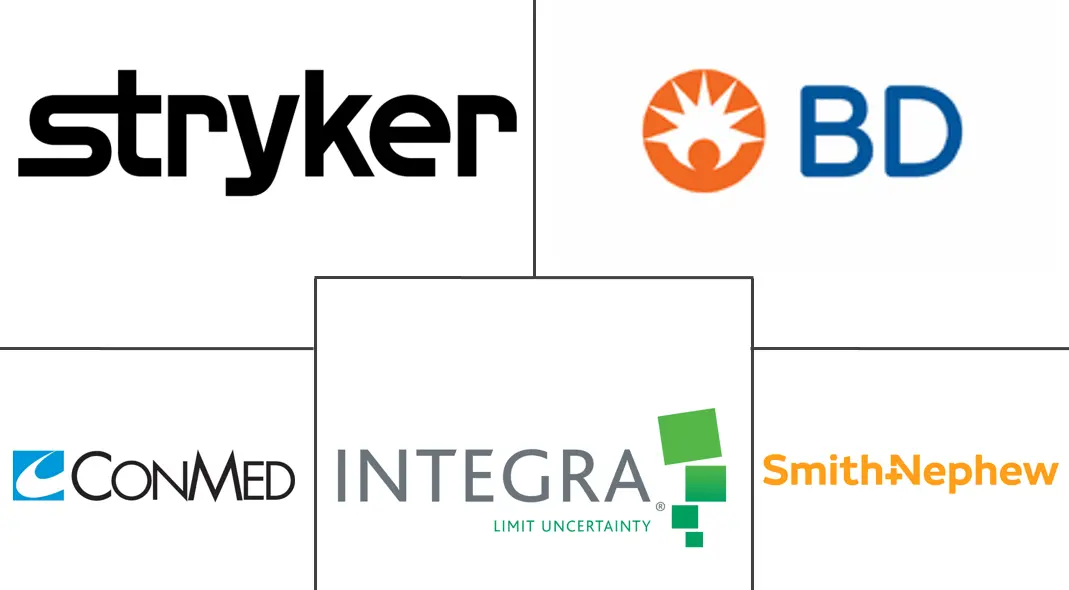Soft Tissue Allografts Market Size and Share
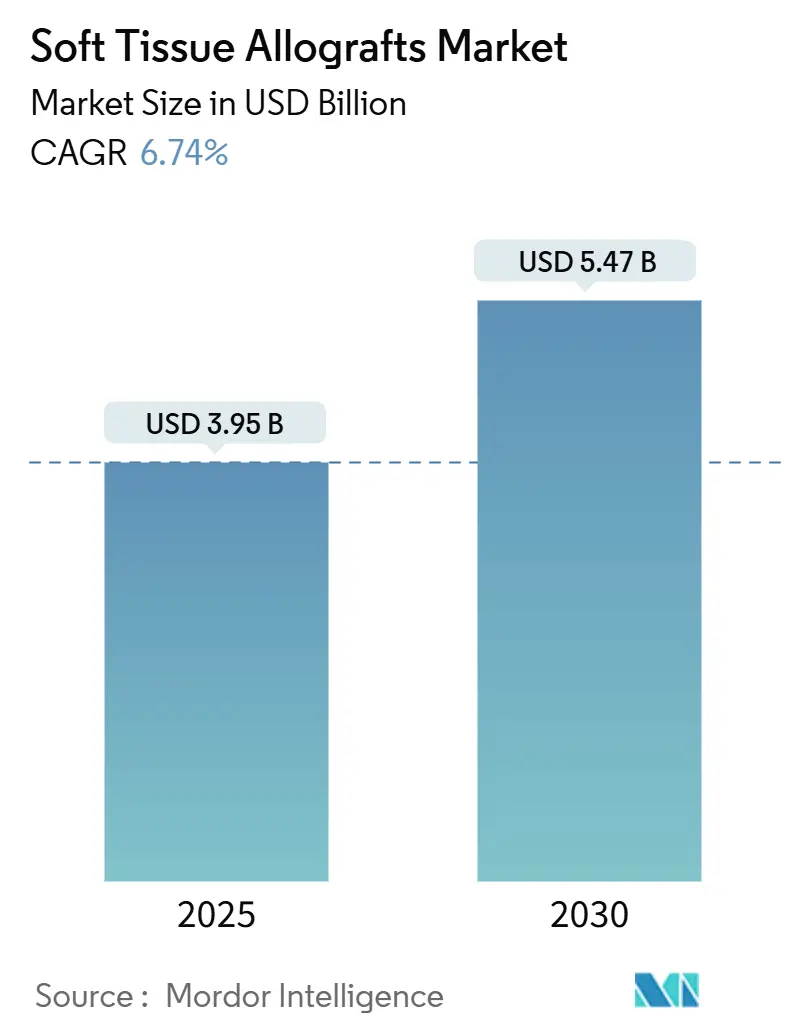
Soft Tissue Allografts Market Analysis by Mordor Intelligence
The soft tissue allografts market size is valued at USD3.95billion in2025 and is forecast to reach USD5.47billion by2030, advancing at a6.74% CAGR. Demand grows steadily as allografts move from experimental use to routine surgical materials in orthopedics, dentistry, wound care, and vascular repair. Adoption is reinforced by improved processing technologies that extend shelf life, lower immunogenicity, and offer better biomechanical performance. At the same time, an aging population and climbing sports‐injury volumes expand the surgical candidate pool, while new reimbursement pathways reduce financial barriers. Heightened regulatory scrutiny—particularly six USFDA guidance documents released inJanuary2025—raises compliance costs yet standardizes quality, favoring processors with robust quality systems. In addition, mergers such as ZimmerBiomet’s USD1.1billion deal for Paragon28 illustrate a race to secure graft supply and distribution channels across diverse specialties.
Key Report Takeaways
- By graft type, tendon allografts led with34.56% revenue share in2024; dental/periodontal grafts are projected to grow at an8.65% CAGR through2030.
- By processing method, fresh-frozen allografts held42.55% of the soft tissue allografts market share in2024, while decellularized and acellular grafts are poised for the fastest8.44% CAGR to2030.
- By application, orthopedic reconstruction accounted for41.56% of the soft tissue allografts market size in2024, but wound and burn management is expanding at a9.32% CAGR to2030.
- By end user, hospitals captured57.34% of the soft tissue allografts market size in2024; ambulatory surgical centers (ASCs) register the highest9.64% CAGR to2030.
- By region, North America dominated with a45.67% revenue share in2024, whereas Asia-Pacific is the fastest-growing geography at7.56% CAGR through2030.
Global Soft Tissue Allografts Market Trends and Insights
Driver Impact Analysis
| Driver | % Impact on CAGR Forecast | Geographic Relevance | Impact Timeline |
|---|---|---|---|
| Rising prevalence of musculoskeletal disorders | +1.8% | Global; strongest in North America & Europe | Long term (≥ 4 years) |
| Expanding geriatric population base | +1.5% | Global; highest in Asia-Pacific & North America | Long term (≥ 4 years) |
| Increasing sports and recreation injuries | +1.2% | North America & Europe; emerging Asia-Pacific | Medium term (2-4 years) |
| Rapid advances in tissue engineering technologies | +2.1% | Global; led by North America with spillover to Europe | Medium term (2-4 years) |
| Growing healthcare expenditure in emerging economies | +1.0% | Asia-Pacific, Latin America, Middle East & Africa | Medium term (2-4 years) |
| Favorable reimbursement and policy support | +0.8% | North America & Europe; gradually expanding in Asia-Pacific | Short term (≤ 2 years) |
| Source: Mordor Intelligence | |||
Rising Prevalence of Musculoskeletal Disorders
Musculoskeletal conditions have shifted the soft tissue allografts market toward predictable, elective procedures instead of sporadic trauma-driven interventions. Chronic knee, shoulder, and spinal pathologies require planned reconstruction, enabling tissue banks to forecast demand, match donor characteristics to recipient needs, and reduce wastage. Aging demographics magnify this trend because degenerative tissue loss in seniors often rules out autografts. Surgeons therefore turn to pre-processed allografts that shorten operating times and avoid donor-site morbidity, producing clinical outcomes that compare favorably with autografts in elderly cohorts[1]National Institutes of Health, “Musculoskeletal Diseases,” nih.gov. The result is a durable demand curve that allows processors to optimize inventory and drives revenue visibility across the soft tissue allografts market.
Expanding Geriatric Population Base
Older patients exhibit limited healing capacity and insufficient autograft sites. Allografts thus become first-line options in complex foot, ankle, and spine surgeries. The FDA’s December2024 approval of Symvess, an acellular tissue-engineered vessel, illustrates a regulatory embrace of advanced allografts for vascular reconstruction in fragile patient groups[2]U.S. Food and Drug Administration, “FDA Clears Symvess Acellular Vessel,” fda.gov. Hospitals now prioritize shorter anesthesia times and fewer complications, favoring off-the-shelf grafts despite higher prices. Consequently, the geriatric demographic strengthens long-term growth for the soft tissue allografts market.
Increasing Sports and Recreation Injuries
Escalating participation in organized sports brings higher rates of ligament and tendon ruptures that demand biomechanically robust grafts. Professional teams and collegiate programs endorse soft tissue allografts for anterior cruciate ligament (ACL) repair because they eliminate donor-site morbidity and enable quicker return-to-play. Supercritical CO₂-sterilized grafts demonstrate outcomes paralleling autografts while trimming rehabilitation intervals[3]National Center for Biotechnology Information, “Supercritical CO₂-Sterilized Allografts in ACL Repair,” ncbi.nlm.nih.gov. Parallel growth in youth athletics cultivates a pipeline of future revision surgeries, reinforcing the expansion trajectory of the soft tissue allografts market.
Rapid Advances in Tissue Engineering Technologies
Decellularization retains extracellular matrices while stripping immunogenic cells, turning grafts into bioactive scaffolds that spur vascular ingrowth and remodeling. New cryopreservation and lyophilization protocols safeguard biomechanical integrity for years, granting tissue banks latitude to balance supply with demand spikes. Processors pioneering fast decellularization for split-thickness skin now cut lead times from weeks to days without compromising sterility. Such technical leaps differentiate premium suppliers and accelerate consolidation across the soft tissue allografts market.
Restraints Impact Analysis
| Restraints Impact Analysis | (~) % Impact on CAGR Forecast | Geographic Relevance | Impact Timeline |
|---|---|---|---|
| High treatment and graft costs | –0.9% | Global; greatest drag in emerging markets | Short term (≤ 2 years) |
| Stringent and fragmented regulatory landscape | –0.6% | Global; variable intensity across regions | Medium term (2-4 years) |
| Limited availability of donor tissue | –0.7% | Global; acute in Asia-Pacific & Latin America | Long term (≥ 4 years) |
| Potential risk of disease transmission | –0.5% | Global; heightened scrutiny in North America & Europe | Short term (≤ 2 years) |
| Source: Mordor Intelligence | |||
High Treatment and Graft Costs
Insurance payers compare allograft charges with autograft alternatives, triggering pre-authorization hurdles that slow adoption, particularly for elective digital nerve repair where median hospital billing reaches USD35,295, exceeding autograft procedures by USD11,224. Providers must now supply clinical data linking graft use to superior function or lower revision rates. Moreover, allografts require validated cold-chain logistics and traceability systems, inflating overhead for hospitals and ASCs. These factors temporarily temper uptake in price-sensitive regions but are unlikely to derail the long‐range expansion of the soft tissue allografts market.
Stringent and Fragmented Regulatory Landscape
The FDA’s six tissue-transplantation guidances, effective2025, tighten donor screening and sterility norms. Internationally, disparate rules for consent, testing, and distribution complicate global supply chains. Compliance lapses can shut facilities, as shown by the December2024 FDA warning letter to Integra LifeSciences for collagen implant issues. Smaller banks, unable to fund new quality systems, may exit or become acquisition targets, nudging the soft tissue allografts market toward larger, vertically integrated entities.
Segment Analysis
By Graft Type: Tendon Dominance Faces Dental Disruption
Tendon allografts accounted for34.56% of2024 revenue, cementing their role in ACL and rotator cuff reconstruction. This segment’s entrenched surgeon familiarity and strong biomechanical performance anchor the soft tissue allografts market. Dental/periodontal grafts, however, register an8.65% CAGR, rising on the back of implant dentistry and ridge augmentation. Dentsply Sirona’s Symbios portfolio underscores how rigorous donor screening and a Sterility Assurance Level of10⁻⁶ resonate with periodontists. Cartilage and meniscus grafts cater to niche joint-surface defects, while ligament grafts contend with autografts in active young adults. Adipose-derived matrices and specialty connective tissues mark early-stage niches but hint at broader reconstructive potential. Competitive emphasis in this graft-type landscape shows processors diversifying lines to de-risk reliance on a single clinical domain, thereby sustaining demand across the soft tissue allografts market.
Surgeons now weigh graft selection against patient age, activity, and healing profile. For example, meniscus allografts appeal to younger athletes needing shock-absorbing properties unavailable in synthetics. Across categories, continuous documentation of long-term outcomes bolsters payer confidence and streamlines reimbursement, feeding back into sustained use throughout the soft tissue allografts market.
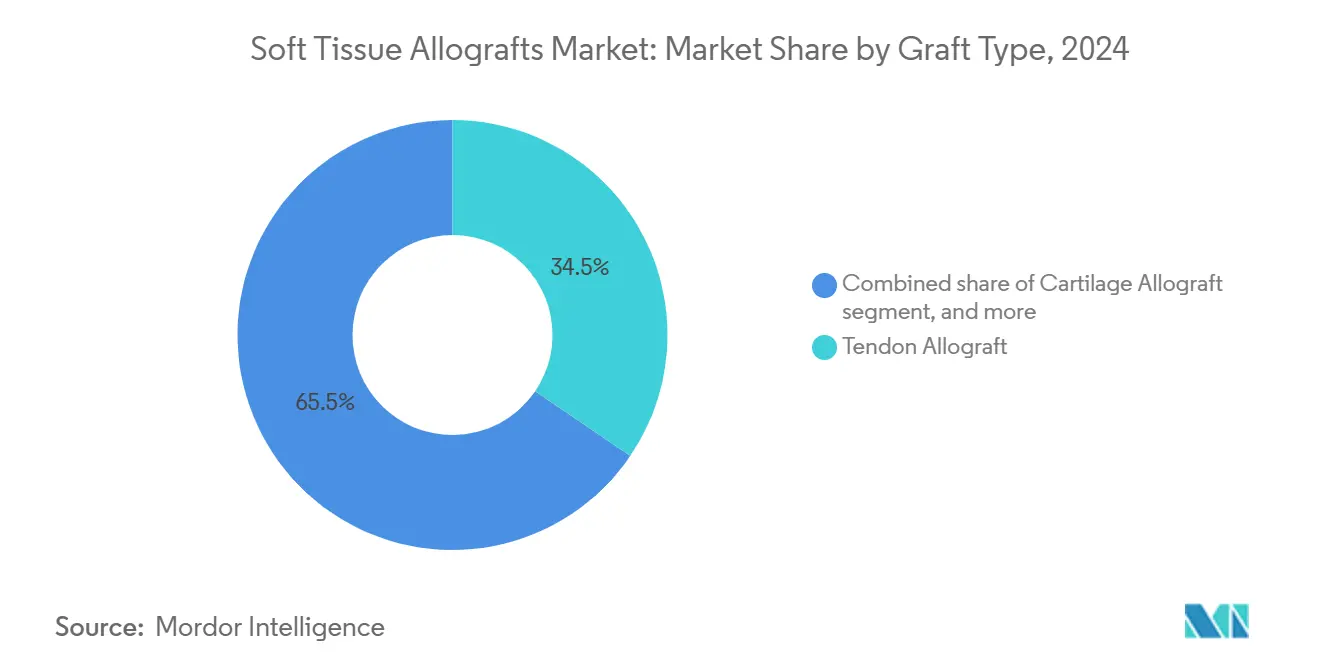
Note: Segment shares of all individual segments available upon report purchase
By Processing & Preservation Method: Fresh-Frozen Legacy Meets Cellular Innovation
Fresh-frozen grafts held42.55% share in2024, benefiting from decades of clinical data and broad operating-room familiarity, positioning them as a staple in the soft tissue allografts market. Nonetheless, decellularized and acellular grafts accelerate at an8.44% CAGR because surgeons prioritize reduced rejection and improved integration. Cryopreservation maintains viable cells for orthopedic cartilage plugs, while lyophilization offers multi-year shelf life ideal for battlefield or rural care. Gamma irradiation remains a sterilization mainstay, though high doses may degrade collagen. In bone repair, demineralized bone matrix bridges classic allografts with synthetic substitutes, preserving osteoinductive proteins.
Selection criteria increasingly pivot on regenerative potential rather than simple availability. High-fidelity decellularization preserves biomechanical integrity and extracellular signaling, facilitating vascular invasion once implanted. Consequently, premium pricing aligns with outcome-focused purchasing, and processors finance R&D to compress processing time, guard growth factors, and scale manufacture. This technological arms race shapes competitive hierarchies inside the soft tissue allografts market.
By Application: Orthopedic Foundation Expands into Wound Innovation
Orthopedic reconstruction comprised41.56% of revenue in2024, confirming its status as the bedrock of the soft tissue allografts market. Yet wound and burn management accelerates fastest, clocking a9.32% CAGR through2030 as studies show skin allografts speed closure, reduce infection, and ease pain in chronic ulcers and burns. Sports medicine leverages sterility and strength to address tendon ruptures in high-performance athletes. Dental grafting outpaces broader dentistry as implant placement rises worldwide, aided by shorter treatment times when periodontal defects are resolved with off-the-shelf matrices. Cosmetic and plastic surgeons also adopt dermal grafts to limit visible scarring.
This diversification insulates suppliers from cyclical fluctuations in any single discipline. Hospitals and ASCs adjust inventory to carry multipurpose grafts compatible with orthopedics and wound care alike, reducing procurement complexity. Therefore, expanding indications and cross-disciplinary proof reinforce market breadth and depth for the soft tissue allografts market.
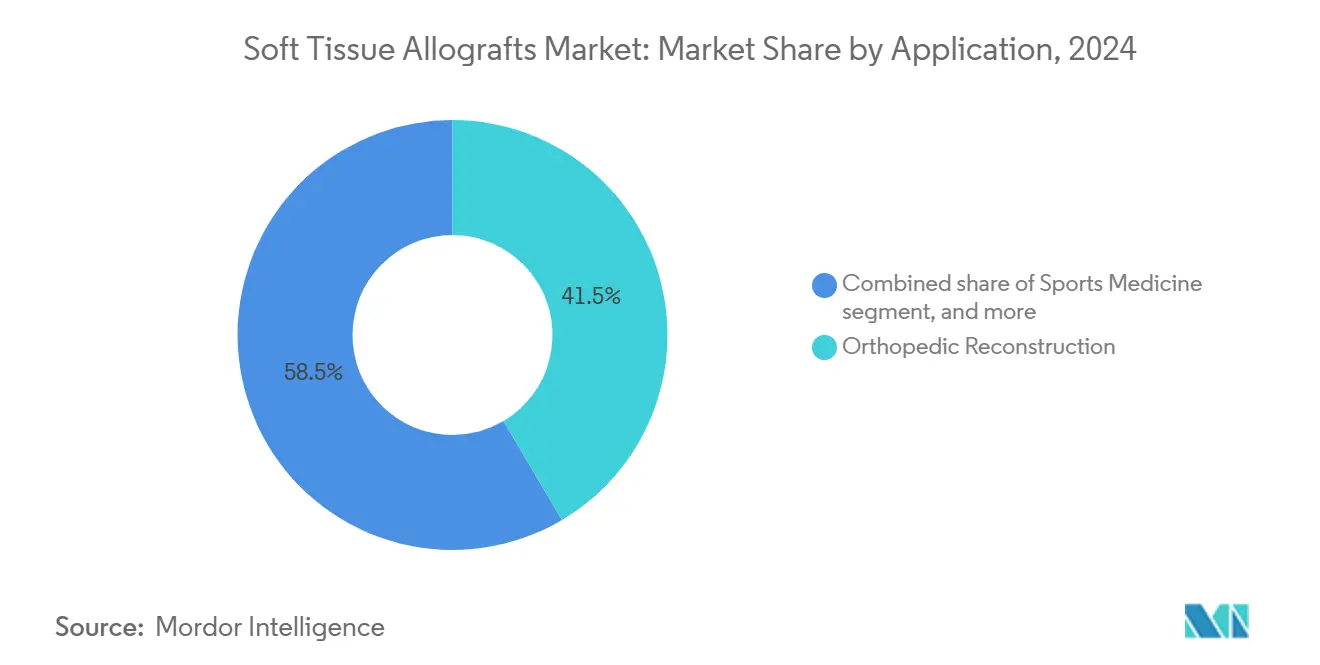
Note: Segment shares of all individual segments available upon report purchase
By End User: Hospital Stability Versus ASC Acceleration
Hospitals retained57.34% of2024 revenues, anchoring the soft tissue allografts market. Their broad caseloads, complex surgeries, and robust cold-chain storage sustain bulk purchases. Nevertheless, ASCs record a9.64% CAGR as payers push procedures into outpatient settings to curb costs. Orthopedic cases such as rotator cuff repair or bunion correction are increasingly scheduled at ASCs, which project21% volume growth to44million procedures by2034. For suppliers, decentralized demand requires smaller shipment lots, streamlined online ordering, and rapid turnaround. Specialty orthopedic clinics, research institutions, and even veterinary surgeons purchase niche grafts, rounding out a diverse customer base. Adapting fulfillment models to serve high-volume hospitals and agile ASCs concurrently becomes key to defending share in the soft tissue allografts market.
Geography Analysis
North America controlled45.67% of2024 revenue, reflecting mature tissue banks, sophisticated reimbursement, and a robust clinical research ecosystem. The presence of large processors such as LifeNet Health and MTF Biologics, together with integrated procurement organizations, ensures reliable donor pools and steady throughput. Despite dominance, value-based care initiatives urge surgeons to prove clinical superiority and cost offsets before selecting premium grafts. Upcoming federal compliance deadlines in2025 also press smaller US banks to merge or close, subtly reshaping regional supply dynamics and reinforcing the centrality of the soft tissue allografts market.
Asia-Pacific is the fastest riser, growing at7.56% CAGR through2030. Japan spearheads regenerative medicine with over60 iPS clinical trials, many intersecting with scaffold technologies that could dovetail with decellularized allografts. China’s regulatory green light for Artivion’s BioGlue in2024 signals openness to complex biologics, while urban hospitals modernize operating suites and cryogenic storage. Elsewhere, India and Southeast Asia benefit from expanding middle-class incomes and health insurance penetration, yet still grapple with fragmented regulations that slow cross-border tissue flow. Nonetheless, regional growth broadens the global footprint of the soft tissue allografts market.
Europe offers stable uptake, underpinned by harmonized directives under the European Union Tissues and Cells legislation that streamline supply across borders. National health systems favor quality-accredited grafts, and many surgeons participate in registries documenting long-term outcomes, strengthening evidence-based procurement. Mid-tier markets like the Middle East, Africa, and South America currently lag because of limited cold-chain infrastructure and higher out-of-pocket costs, yet represent long‐range opportunities as private specialty hospitals proliferate. Consequently, strategic expansion plans increasingly balance the mature North American base with Asia-Pacific momentum, while nurturing footholds in emerging geographies to secure future share in the soft tissue allografts market.
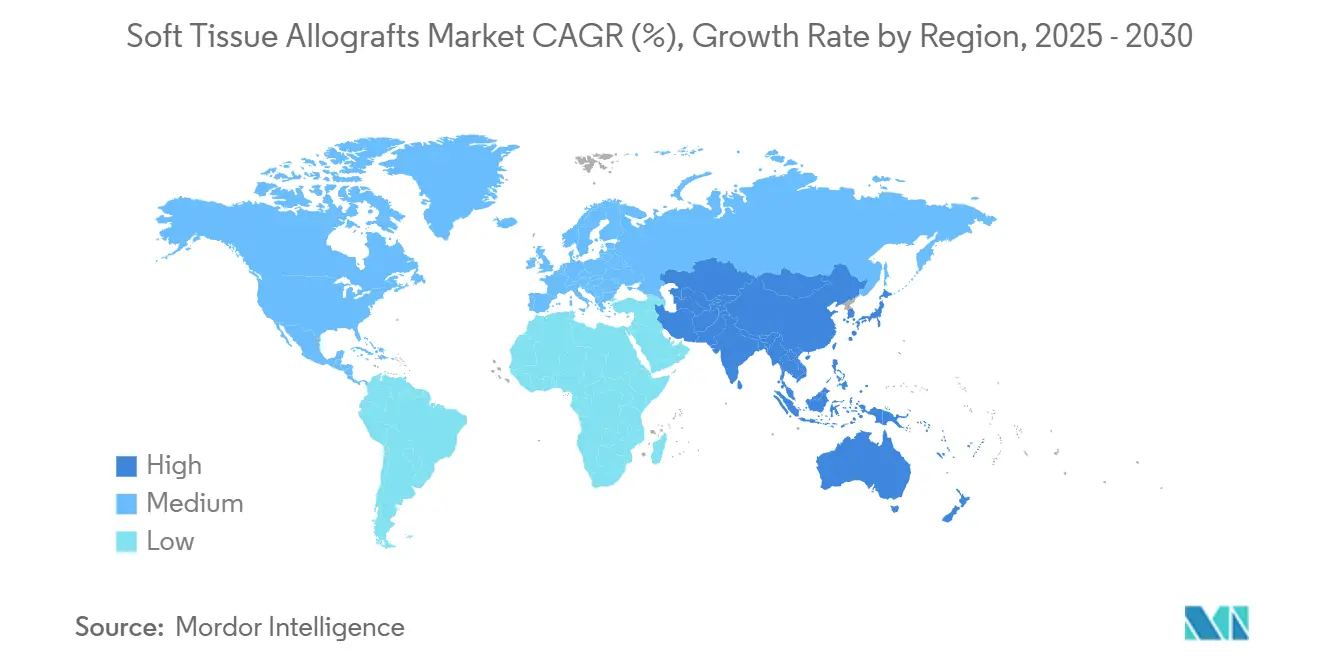
Competitive Landscape
Global competition is moderately consolidated. Stryker, Johnson&Johnson, Medtronic, ZimmerBiomet, LifeNetHealth, and MTFBiologics lead, drawing strength from vertical integration—securing donor programs, proprietary processing, and global distribution. ZimmerBiomet’s January2025 acquisition of Paragon28 for USD1.1billion extends its foot-and-ankle graft catalog while diversifying beyond core arthroplasty. Device manufacturers pair implants with matched grafts to create procedure kits that simplify surgery and boost brand loyalty. Smaller tissue banks often pursue niche differentiation—such as neonatal skin grafts or adipose matrices—yet face swelling capital demands to maintain compliance.
Technology is an equally sharp wedge. Firms investing in decellularization, lyophilization, and supercritical sterilization gain premium price points. For instance, LifeNetHealth’s Matracell protocol removes ≥97% of donor DNA while retaining tensile strength, earning surgeon favor for shoulder repairs. Regulatory prowess is another moat; Integra LifeSciences’ December2024 FDA warning letter shows how lapses threaten US revenue streams. Competitive intelligence therefore focuses on pipeline innovations, facility audits, and geographic approvals that can swing share in the soft tissue allografts market.
Partnerships flourish as processors team with biotech or synthetic scaffold firms to co-develop hybrid products. MTFBiologics’ May2025 collaboration with Kolosis Bio introduces cardiac-specific grafts, unlocking an adjacency beyond orthopedics. Such moves underline a race to capture under-served procedures, reinforcing long-term growth avenues throughout the soft tissue allografts market.
Soft Tissue Allografts Industry Leaders
-
Stryker Corporation
-
CONMED Corporation
-
Integra LifeSciences Corporation
-
Smith & Nephew (Osiris Therapeutics Inc.)
-
BD (Becton Dickinson and Company)
- *Disclaimer: Major Players sorted in no particular order
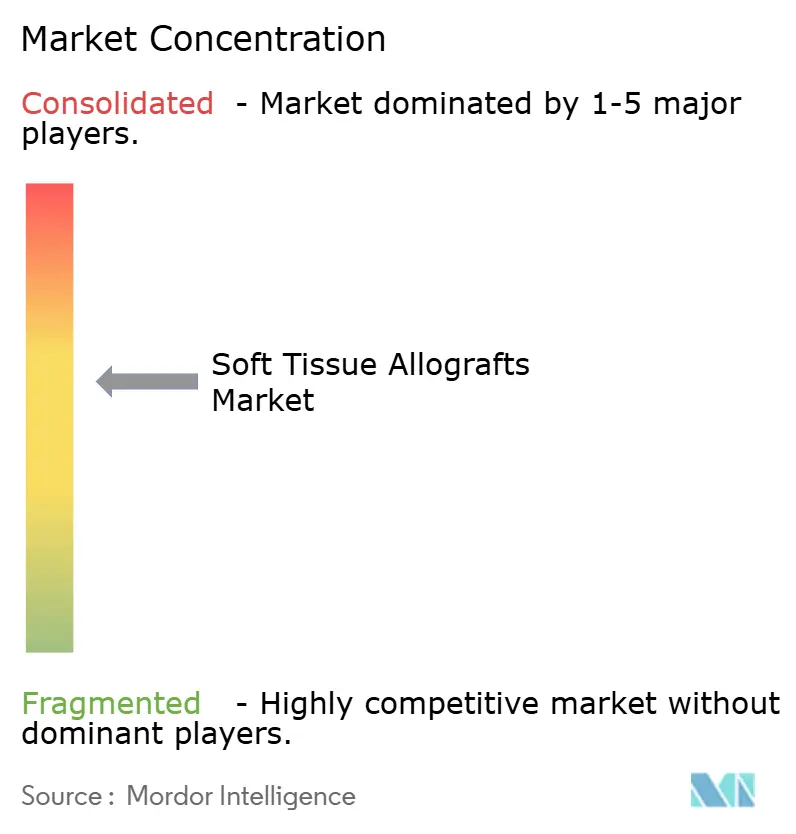
Recent Industry Developments
- August 2022: orthopedic surgeons at University National Hospital performed the first meniscal transplant and implanted donor cartilage into the patient's knee in Scotland.
- July 2022: AlloSource added a quadricep tendon to its AlloConnex line of tendons, ligaments, and fascia. AlloSource's AlloConnex quadricep tendon is used for cruciate ligament procedures and is available with or without the bone block for various surgical techniques.
Research Methodology Framework and Report Scope
Market Definitions and Key Coverage
Our study defines the soft tissue allografts market as donor-derived tendon, ligament, meniscus, cartilage, dermal, and dental grafts that are processed, sterilized, and implanted to restore musculoskeletal or oral soft-tissue function. These products move through regulated tissue banks and are sold to hospitals, ambulatory surgical centers, and specialty dental or orthopedic clinics worldwide.
Scope exclusion: Autologous grafts, xenografts, synthetic meshes, and biologic matrices used purely for wound dressings are outside this analysis.
Segmentation Overview
- By Graft Type
- Cartilage Allograft
- Tendon Allograft
- Meniscus Allograft
- Ligament Allograft
- Dental/Periodontal Allograft
- Other Graft Types
- By Processing & Preservation Method
- Fresh-Frozen
- Cryopreserved
- Lyophilized
- Gamma-Irradiated Sterilized
- Decellularized & Acellular
- Demineralized Bone Matrix (DBM)
- By Application
- Orthopedic Reconstruction
- Sports Medicine
- Dentistry & Periodontics
- Wound & Burn Management
- Cosmetic & Plastic Surgery
- Other Applications
- By End User
- Hospitals
- Ambulatory Surgical Centers
- Orthopedic Specialty Clinics
- Other End Users
- Geography
- North America
- United States
- Canada
- Mexico
- Europe
- Germany
- United Kingdom
- France
- Italy
- Spain
- Rest of Europe
- Asia-Pacific
- China
- Japan
- India
- Australia
- South Korea
- Rest of Asia-Pacific
- Middle East & Africa
- GCC
- South Africa
- Rest of Middle East & Africa
- South America
- Brazil
- Argentina
- Rest of South America
- North America
Detailed Research Methodology and Data Validation
Primary Research
Mordor analysts spoke with orthopedic surgeons, sports-medicine physicians, maxillofacial dentists, tissue-bank managers, and procurement heads across North America, Europe, and Asia-Pacific. Interviews and brief online surveys validated average processed-graft yields, price corridors, adoption barriers, and upcoming regulatory inflection points, closing gaps that desk work alone could not bridge.
Desk Research
We began with public datasets that track graft recovery and utilization, such as the US FDA HCT/P establishment registry, American Association of Tissue Banks annual survey, EuroGraft, and national procedure statistics from CMS and OECD health indicators. Trade literature, peer-reviewed journals, and patent filings helped us map new decellularization and cryopreservation techniques. Financial filings gathered through D&B Hoovers and headline news archived on Dow Jones Factiva supplied company-level revenue splits and expansion moves.
Additional context on donor availability, consent laws, and reimbursement rules was compiled from WHO Global Health Expenditure, EUNetHTA briefings, and major orthopedic societies. The desk-research list is illustrative; many other sources supported data checks and clarifications.
Market-Sizing & Forecasting
A top-down reconstruction starts with country-level procedure volumes for ACL repair, rotator-cuff, meniscal, cartilage, dental membrane, and burn reconstructions, which are then multiplied by graft-use incidence and weighted average selling price to derive the value. Select bottom-up roll-ups, such as shipment audits, tissue-bank release numbers, and sampled distributor checks, corroborate and adjust totals. Key variables modeled include sports-injury incidence, population over 65, elective-surgery rebound rates, regulatory clearance times, and donor-consent ratios. Multivariate regression, stress-tested through scenario analysis, projects demand over the forecast period, while missing bottom-up datapoints are imputed from nearest proxy markets and cross-verified with expert consensus.
Data Validation & Update Cycle
Outputs pass variance screens against external price and volume benchmarks; anomalies trigger secondary reviews and fresh respondent callbacks before sign-off. Reports refresh annually, and material events, such as policy shifts, recalls, and major M&A, prompt interim model tweaks so clients receive the latest view.
Why Mordor's Soft Tissue Allografts Baseline Commands Reliability
Published estimates often differ because firms choose dissimilar graft types, pricing assumptions, and refresh cadences. According to Mordor Intelligence, clear scope discipline and an annually rebuilt model reduce such drift.
Key gap drivers include whether dental and skin matrices are counted, the use of hospital list prices versus ex-factory averages, currency-conversion timing, and how aggressively future sports-injury growth is projected.
Benchmark comparison
| Market Size | Anonymized source | Primary gap driver |
|---|---|---|
| USD 3.95 B (2025) | Mordor Intelligence | - |
| USD 5.04 B (2025) | Global Consultancy A | Combines xenografts and autologous tissue; applies hospital list prices |
| USD 5.09 B (2024) | Industry Association B | Includes dental membranes and uses 2023 FX rates |
| USD 4.02 B (2024) | Trade Journal C | Excludes spinal grafts; volume-only model without ASP adjustment |
The comparison shows that once scope creep, price-point choice, and base-year mismatch are stripped away, our 2025 baseline offers a balanced, transparent figure that decision-makers can retrace to publicly verifiable variables and repeatable steps.
Key Questions Answered in the Report
What is the current value of the soft tissue allografts market?
The market stands at USD 3.95 billion in 2025 and is projected to reach USD 5.47 billion by 2030.
Which graft type leads revenue today?
Tendon allografts command the largest 34.56% share, driven by ACL and rotator cuff repairs.
Who are the key players in Soft Tissue Allografts Market?
ASCs grow at a 9.64% CAGR and shift procurement from large hospital batches to smaller, rapid-turn orders, requiring new distribution models.
How will FDA guidance released in 2025 influence suppliers?
Stricter donor screening and processing rules raise compliance costs, pressuring smaller banks to merge or exit.
Which region is expanding fastest?
Asia-Pacific posts a 7.56% CAGR as healthcare access widens and regulatory approvals for biologics accelerate.
What technology trend most affects graft selection?
Decellularization and acellular processing improve integration and reduce rejection, prompting more surgeons to choose these advanced grafts over traditional fresh-frozen products.
Page last updated on:
